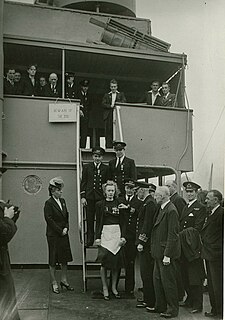
Johan Ludwig Mowinckel (22 October 1870 – 30 September 1943) was a Norwegian statesman, shipping magnate and philanthropist. He served as the Prime Minister of Norway during three separate terms.

The Norwegian campaign describes the attempt of the Allies to defend northern Norway coupled with Norwegian forces' resistance to the country's invasion by Nazi Germany in World War II.
Atle Thowsen is a historian and the Director of the Bergen Maritime Museum and served as president of the International Commission for Maritime History from 2000 to 2005.

SS Henry was a Norwegian steam-powered cargo ship best known for being one of the two ships sunk in one of the most controversial incidents in Norway during the Second World War.

Hiltgunt Margret Zassenhaus was a German philologist who worked as an interpreter in Hamburg, Germany during World War II, and later as a physician in the United States. She was honoured for her efforts to aid prisoners in Nazi Germany during World War II.
Milly Elise "Lise" Børsum was a Norwegian resistance member during World War II, survivor from the Ravensbrück concentration camp, and known for her writings and organizing work after the war.
Roy Nielsen was a Norwegian resistance member during World War II, a member of Milorg and involved in propaganda and sabotage. Among his sabotage operations was the destruction of 25 Messerschmitt fighter aircraft and 150 engines stored in a bus garage in Oslo, on 14 August 1944, together with Max Manus, Gunnar Sønsteby and others. Together with Max Manus he succeeded in sinking the German troop ship SS Donau in the Oslofjord 16 January 1945, by placing magnetic limpet mines with time delay on the ship's side.
Operation Bittern was a military operation in occupied Norway planned and carried out in 1942 by the British Special Operations Executive (SOE) and the Norwegian government-in-exile in London.
Nini Haslund Gleditsch was a Norwegian political activist and advocate for peace.
The milk strike was a strike in Nazi-occupied Oslo on 8 and 9 September 1941. It led to strong reprisals from the German occupiers, in the form of martial law, court-martial, mass arrests, two executions and several long-term jail sentences.
Odd Fossum was a Norwegian shop assistant, and leader of the Norwegian Confederation of Trade Unions from 1941 to 1945, under the Nazi regime during the occupation of Norway by Nazi Germany. He was also the leader of NS Faggruppeorganisasjon from 12 October 1940 to September 1944, when he was succeeded by Olav M. Hoff.
Arnt Jacobsen Mørland was a Norwegian ship-owner, resistance member, and politician for the Christian Democratic Party.
MS Ravnaas was a Norwegian cargo ship built in 1931, and sunk by Japanese aircraft in the Pacific Ocean in December 1941.
MT Vardaas was a Norwegian oil tanker, built in 1931. She could carry 12,683 DWT. Sailing for Arnt J. Mørland's shipping company and Nortraship, while on its way from Cape Town to Trinidad carrying dead freight, the ship was hit by a torpedo from the German submarine U-564 on 30 August 1942. All crew of 41 escaped in lifeboats and landed in Plymouth Bay, Tobago.

MV B. P. Newton was a Norwegian tanker built in 1940, and sunk by German submarine off South America in July 1943.
MV Storsten was a Norwegian tanker built in 1926, and sunk by German aircraft in the Skagerrak on 1 April 1942.
MTB 345 was an experimental motor torpedo boat constructed in 1941, which saw limited service with the Royal Navy before being transferred to the exiled Royal Norwegian Navy on 16 March 1943. She sailed with the Royal Norwegian Navy for three months in 1943, until captured by German forces on 28 July 1943, during her second mission to the coast of occupied Norway. Two days after their capture, the crew of MTB 345 were executed by the Germans based on Hitler's Commando Order. Following their capture of MTB 345, the Germans pressed the motor torpedo boat into Kriegsmarine service, renaming her SA 12. The fate of SA 12 since December 1943 is unknown.

Eric Welsh was a British chemist and naval intelligence officer during the Second World War. Between 1919 and 1940 he worked for the Bergen branch of the company International Paint Ltd. From 1941 he headed the Norwegian branch of Secret Intelligence Service (SIS). Welsh is fleetingly referred to in the Norwegian television series The Heavy Water War and, based on the comments by Stephen Dorril of Welsh as a "...ladies' man who drank and smoked to excess" and a "master of dirty tricks" alluded to as one of the models to James Bond
Per Askim was a Norwegian naval officer who was in command of the two coastal defence ships defending Narvik during the German invasion of Norway on 9 April 1940.

Margit Johnsen Godø,, nicknamed Malta-Margit, was a Norwegian sailor in the merchant navy. For her service on a merchant vessel in convoy to Malta in 1942 she was awarded the St. Olav's Medal with Oak Branch and several other gallantry decorations. Johnsen continued her work in the Norwegian merchant fleet until 1960. Her story is told in maritime and wartime history as an example of Norwegian women's effort during World War II.







